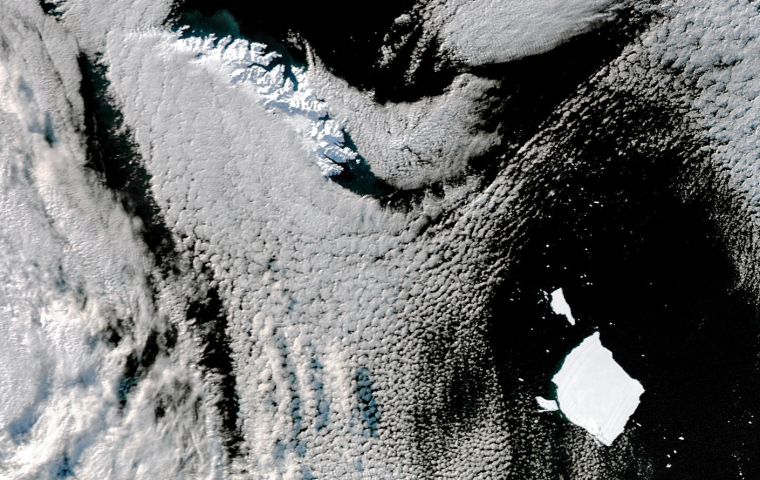MercoPress. South Atlantic News Agency
South Georgia, forty year old Antarctica iceberg breaking up and drifting north
 NASA Earth Observatory image by Michala Garrison using MODIS data from NASA EOSDIS LANCE and GIBS/Worldview. Story by Kathryn Hansen, with science review by Christopher Shuman, UMBC (retired)
NASA Earth Observatory image by Michala Garrison using MODIS data from NASA EOSDIS LANCE and GIBS/Worldview. Story by Kathryn Hansen, with science review by Christopher Shuman, UMBC (retired) Almost four decades after breaking from Antarctica’s Filchner Ice Shelf, a still massive iceberg is showing its age. The berg, named A-23A, is shedding large chunks of ice as it drifts in the southern South Atlantic Ocean, about 2,400 kilometers north of its birthplace.
Starting around March first, 2025, the iceberg sat stuck on the shallow continental shelf around South Georgia, the largest of nine remote islands that compose the South Georgia and South Sandwich Islands British Overseas Territories. Icebergs that make it this far north are increasingly at the mercy of warm water, waves, and seasonal weather—factors that contribute to a berg’s ultimate demise.
After losing some pieces from its edge, A-23A wiggled off the shelf by late May 2025 and resumed its drift toward the eastern side of South Georgia, following the same currents previously ridden by the massive A-68A iceberg in late 2020. The austral winter journey continued to inflict damage on A-23A, which shed even more ice from its sides.
Two of the new pieces were large enough to be named and tracked by the US National Ice Center (USNIC). Jan Lieser of Australia’s Bureau of Meteorology first identified the bergs using NovaSAR-1 radar data, and later confirmed by USNIC analyst Britney Fajardo in radar images acquired by the European Space Agency’s Sentinel-1 mission on July 15, 2025. “Radar satellites can take images of the Earth at polar night and through all weather conditions, including heavy clouds and even smoke,” Lieser said.
As sunlight returns to Antarctica after the polar night, Lieser also checks for icebergs in visible imagery. A break in the clouds and lengthening daylight hours on July 22, 2025, allowed the MODIS (Moderate Resolution Imaging Spectroradiometer) on NASA’s Aqua satellite to capture this natural-color image of A-23A and the new bergs near South Georgia. Around this time, A-23A’s surface spanned 2,510 square kilometers. The new pieces, A-23D and A-23E, measured 159 and 73 square kilometers respectively.
Despite these edge losses, A-23A is still the largest iceberg currently drifting freely in any of the world’s oceans. (Only D-15A is larger, but that berg lies grounded in the cold Amery Sea off East Antarctica.) As lengthening daylight hours come to this part of the South Atlantic, scientists expect more calving from the remnant of A-23A as it moves even farther north.




Top Comments
Disclaimer & comment rulesCommenting for this story is now closed.
If you have a Facebook account, become a fan and comment on our Facebook Page!